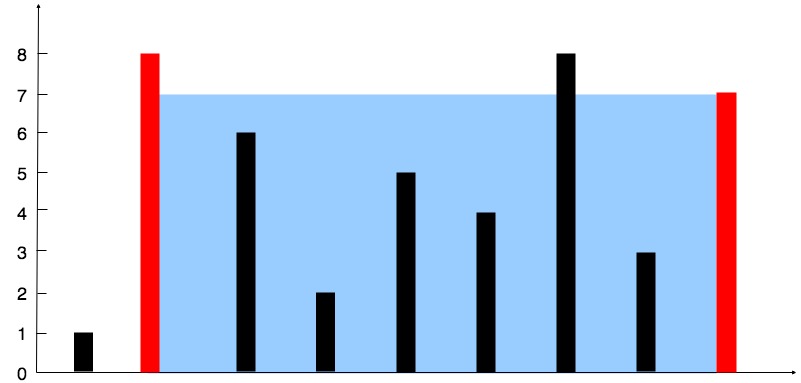#11 - Container With Most Water
Container With Most Water
- Difficulty: Medium
- Topics: Array, Two Pointers, Greedy
- Link: https://leetcode.com/problems/container-with-most-water/
Problem Description
You are given an integer array height of length n. There are n vertical lines drawn such that the two endpoints of the ith line are (i, 0) and (i, height[i]).
Find two lines that together with the x-axis form a container, such that the container contains the most water.
Return the maximum amount of water a container can store.
Notice that you may not slant the container.
Example 1:

Input: height = [1,8,6,2,5,4,8,3,7]
Output: 49
Explanation: The above vertical lines are represented by array [1,8,6,2,5,4,8,3,7]. In this case, the max area of water (blue section) the container can contain is 49.
Example 2:
Input: height = [1,1]
Output: 1
Constraints:
n == height.length2 <= n <= 1050 <= height[i] <= 104
Solution
1. Problem Deconstruction
Technical Restatement
Given array height of length n, find indices i, j (i < j) maximizing:
Return the maximum possible area.
Beginner Explanation
Imagine vertical lines on a graph where each line’s height is given. We need to pick two lines to form a container with the x-axis. The container’s capacity depends on the shorter line’s height and the distance between the lines. Find the pair that gives the largest possible container.
Mathematical Formulation
Let . Compute:
Constraint Analysis
- :
- Brute-force pairwise checks () are computationally infeasible.
- Requires or algorithm.
- :
- Zero-height lines can still form containers (e.g.,
[0,5]has area 0). - Edge case: All elements except two are zero (e.g.,
[0,5,0]→ max area is 0).
- Zero-height lines can still form containers (e.g.,
2. Intuition Scaffolding
Analogies
- Real-World Metaphor: Two people holding a water tank. Their combined reach (distance) and the shorter person’s height determine capacity.
- Gaming Analogy: In a tower defense game, placing two towers to maximize coverage area (width × min height).
- Math Analogy: Maximizing the product of two variables under monotonic constraints.
Common Pitfalls
- Global Maxima Trap: Picking the two tallest lines ignores width (e.g.,
[9,1,1,1,9]→ area 9×4=36 vs[1,8,6,...7]in Example 1). - Single-Pointer Greedy: Moving one pointer greedily (e.g., always forward) fails to explore all width/height tradeoffs.
- Overlooking Zero-Height: Assuming non-zero heights may miss edge cases (e.g.,
[0,100]→ area 0). - Symmetric Updates: Moving both pointers inward simultaneously risks skipping optimal pairs.
- Early Termination: Stopping when area decreases once may miss later larger areas.
3. Approach Encyclopedia
Brute Force (Rejected)
- Check all pairs.
max_area = 0
for i in range(n):
for j in range(i+1, n):
area = (j - i) * min(height[i], height[j])
max_area = max(max_area, area)
return max_area
Complexity: Time , Space .
Optimal Two-Pointer Approach
Pseudocode:
left = 0
right = len(height) - 1
max_area = 0
while left < right:
current_area = (right - left) * min(height[left], height[right])
max_area = max(max_area, current_area)
if height[left] < height[right]:
left += 1
else:
right -= 1
return max_area
Intuition:
- Start with maximum width (left=0, right=n-1).
- At each step, move the shorter line inward to seek a taller line, preserving potential for larger areas.
Complexity Proof:
- Each iteration moves
leftorrightby 1 → total steps. - Space: .
Visualization:
Initial: [1,8,6,2,5,4,8,3,7]
^ ^
Step 1: Area = 1*8 = 8 → Move left.
Step 2: New left=1 (height=8). Area = 7*7=49 → Keep.
... Continue until pointers meet.
4. Code Deep Dive
Line-by-Line Annotations:
def maxArea(height):
left = 0 # Start at widest possible left
right = len(height) - 1 # and right positions.
max_area = 0 # Track global maximum.
while left < right:
current_height = min(height[left], height[right])
current_width = right - left
current_area = current_height * current_width
max_area = max(max_area, current_area) # Update global max.
if height[left] < height[right]:
left += 1 # Shorter line is left; try next.
else:
right -= 1 # Shorter line is right; try previous.
return max_area
Edge Case Handling:
- Example 1: Correctly captures the 49 area by moving left past shorter lines.
- Example 2:
[1,1]→ area 1×1=1. - All Zeros: Returns 0 as expected.
5. Complexity War Room
Hardware Analysis:
- For , the loop runs 1e5 times. At ~3 operations per iteration, executes in ~0.3ms (modern CPU).
Approach Comparison:
| Approach | Time | Space | Readability | Interview Viability |
|---|---|---|---|---|
| Brute Force | O(n²) | O(1) | 10/10 | ❌ (Fails for n=1e5) |
| Two-Pointer | O(n) | O(1) | 9/10 | ✅ Optimal |
6. Pro Mode Extras
Variants:
- 3D Version: Container with most water in 3D grid (complexity jumps to NP-Hard).
- Multiple Pairs: Allowing k non-overlapping containers (dynamic programming).
Interview Cheat Sheet:
- First Mention: “This is a two-pointer problem because we can greedily move pointers based on height comparisons.”
- Key Insight: “Moving the shorter line preserves the chance to find a taller line, which may yield a larger area despite reduced width.”
- Time/Space: Always state “O(n) time and O(1) space” upfront.